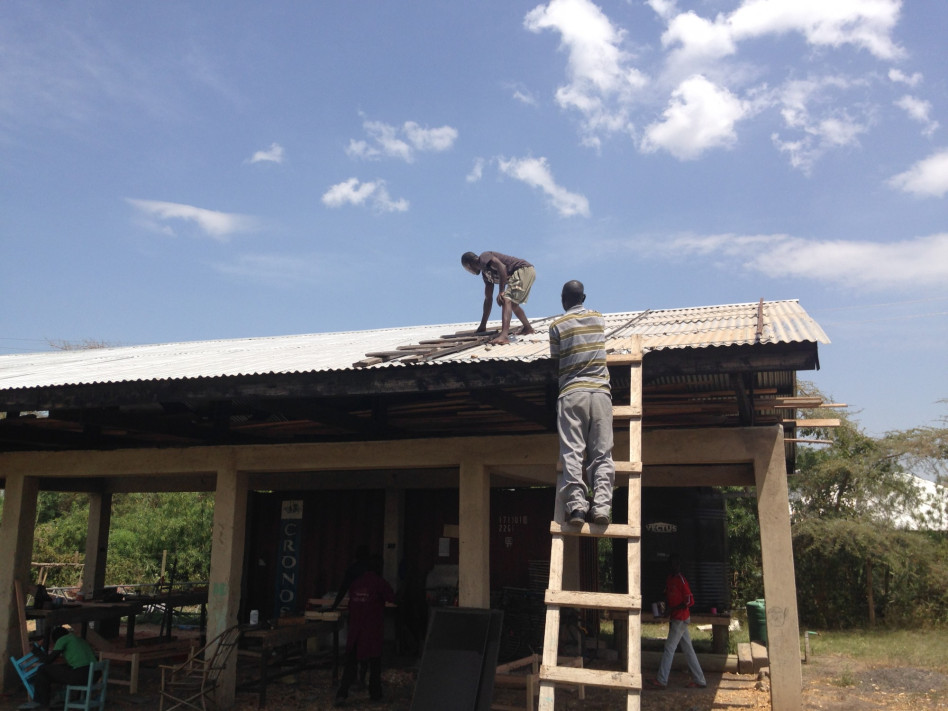Electrifying the SRI compound
Jambo sana! Habari gani? (Hello, how is it going?). At the small supermarket around the corner are always several people to chat with. This small supermarket can afford a connection to the electricity grid and will charge your cell phone for only 10 Kenyan Shilling (10 eurocent). Something like a busy schedule in Africa is almost non-existent, so the people take their time and will wait for two hours untill their phone is fully charged.
Around 90% of the rural population in Kenya has no access to electricity. As a result, those houses are more likely to be robbed, kids cannot do their homework after school (it’s getting dark around 18:30 every day), food cannot be stored and people are using dangerous oil lamps as an alternative. Moreover, in rural Africa, almost everyone has a cellphone and sometimes people have to walk for miles in order to find a place to charge it. Without exaggerating it can be said that after having enough food and water, electricity is a necessity of life.
Here in the Netherlands, we have Nuon and Tennet who respectively produce and deliver electricity that is reliable, clean and affordable for everyone. In Kenya, people have to rely on the state owned company, Kenya Power, that’s producing and delivering electricity at the same time. Just like any other organization that is owned by the Kenyan government, Kenya Power is also inefficient, corrupt and has not the capacity to provide its citizens with affordable and reliable electricity.
As part of my bachelor thesis, I’m residing in a small village called Okana, about 15km east of Kisumu, the third city of Kenya. I’m doing this for a NGO called SRI (Sustainable Rural Initiatives), a partner organization of S4S. Around two years ago, a Dutch organization donated 120 solar panels, but they yet need to be installed. My task to install those solar panels and to look for alternatives for what SRI can do with this overcapacity (the panels produce around 7,5 kW if they are all installed and that is more than SRI is using).
SRI itself has a connection to the grid, but this is not a guarantee for having power 24/7. Just a week ago the compound didn’t had power for more than two days. Except for the people who live here (included me), there is also a carpentry workshop that teaches and employs local youth. This workshop generates is own income by selling the products they make. You can imagine that the often occurring power cuts have an extremely negative impact on the output of the workshop. This results in declining revenues and therefore less salary for the youth.
Thanks to the S4S fund, the solar panels can finally be installed which means that there will be cheap, clean and 24/7 electricity on the compound. A lot of the equipment has already been donated, so the available money will mostly be used for welding and painting the frames, and for buying the wires to interconnect all the elements of the solar panels. In contrast to the Netherlands, in Kenya labor is just a small part of the budget; a welder, painter or electrician works for around 4 euro’s a day.
As of today, the frames for the solar panels have been welded and painted and next week the electrician will come to connect the solar system. Hopefully in two weeks, the compound will always have access to electricity. It will not only increase the productivity of the carpentry workshop, but also the productivity of any foreign student that resides here (the battery of my laptop is not that great, so during a power cut after one hour of typing, I’m done).
My task is to coordinate this project and make sure it stays within the budget and time limits. I also have to find out for SRI what it can do with its electricity producing overcapacity. Can we deliver power to neighboring houses? Or should we install solar panels on those individual houses? Or is it maybe a good idea to provide the people in the community with a battery which they can charge for a small fee at SRI in order for them to charge their phone and light up their houses? And how do we make sure that all this expensive equipment will not be stolen or being sold to the highest bidder? These are also things you have to take into account when doing a project in Africa. But in my opinion, just that makes it so interesting to do a project in this part of the world.
Having access to electricity will contribute a lot to the living standards of the local community here in Okana. At the small supermarket around the corner it will unfortunately be less busy. But hey, I’m the last one to admit that technological development will contribute to social interaction. I will miss it here when I’m back in the Netherlands, sitting in an overcrowded NS train, with my earplugs in, looking at my Iphone.

